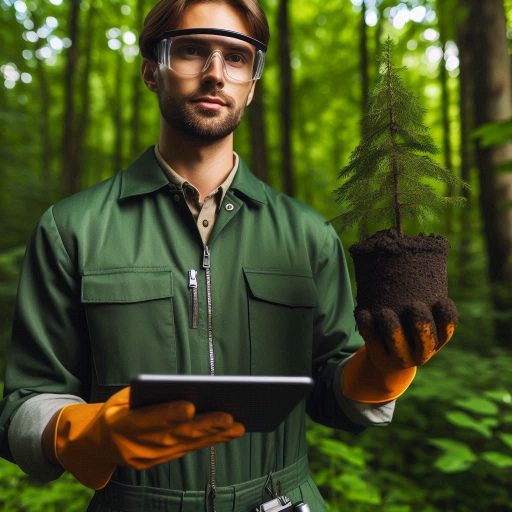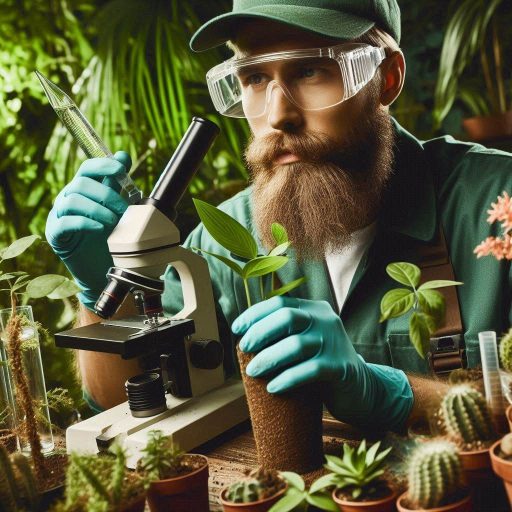Introduction
Environmental technicians play a crucial role in conserving the environment.
They ensure ecosystems remain balanced and sustainable.
Their work involves monitoring, testing, and evaluating environmental data to identify and mitigate potential threats.
Without their expertise, environmental degradation could occur unchecked, leading to severe consequences for both natural habitats and human communities.
Their work is essential in maintaining the delicate balance of our ecosystems.
The Key Role of Tools in Facilitating Their Work
Environmental technicians rely heavily on tools to carry out their responsibilities effectively.
These tools allow them to collect accurate data, analyze samples, and implement solutions.
Each tool serves a specific purpose, enabling technicians to perform tasks efficiently and with precision.
Without these tools, their ability to protect and preserve the environment would be significantly hindered.
Whether it‘s for air quality testing, water sampling, or soil analysis, the right tools are indispensable in their work.
Tools not only enhance accuracy but also ensure safety during fieldwork, making them essential for every environmental technician.
Soil Testing Equipment
Soil testing is a critical aspect of environmental monitoring that helps assess the health of soil and identify pollution levels.
It provides valuable insights into the quality of soil and its impact on the ecosystem.
Significance of Soil Testing in Environmental Monitoring
Soil testing plays a crucial role in environmental monitoring as it helps in assessing the overall health of the soil.
By analyzing different parameters such as pH levels, moisture content, and nutrient levels,
environmental technicians can determine the quality of soil and its ability to support vegetation and wildlife.
List of Essential Tools
- pH Meters: pH meters are essential tools for measuring the acidity or alkalinity of the soil.
They provide valuable information about soil conditions and help in determining the suitability of the soil for plant growth. - Soil Moisture Meters: Soil moisture meters are used to measure the moisture content in the soil.
They help in determining the water holding capacity of the soil, which is crucial for plant growth and ecosystem health. - Soil Sampling Kits: Soil sampling kits are used to collect soil samples for testing and analysis.
They include tools such as soil augers, coring tools, and soil probes, which are essential for collecting accurate and representative soil samples for laboratory testing.
Use of Soil Testing Equipment
These tools are instrumental in evaluating soil health and pollution levels.
pH meters help in assessing soil acidity, which can impact nutrient availability and plant growth.
Soil moisture meters provide insights into soil moisture levels, which are essential for determining irrigation requirements and preventing waterlogging or drought conditions.
Soil sampling kits are crucial for collecting soil samples from different depths and locations to assess soil quality and identify contaminants.
In essence, soil testing equipment is indispensable for environmental technicians in monitoring soil health and pollution levels.
These tools provide valuable data that informs decision-making and helps in developing effective strategies for soil conservation and environmental protection.
Read: CAD Technician vs. Draftsman: Key Differences
Air Quality Monitoring Instruments
Monitoring air quality is crucial for environmental protection as it helps in ensuring clean air standards and detecting pollutants.
Here are some essential tools used by environmental technicians:
Gas Analyzers
- Gas analyzers are instrumental in measuring the concentration of various gases in the air.
- These tools help in identifying pollutants such as carbon monoxide, sulfur dioxide, and nitrogen oxides.
- By detecting these harmful gases, environmental technicians can take necessary actions to mitigate their impact on air quality.
Particulate Samplers
- Particulate samplers are used to collect and analyze solid and liquid particles in the air.
- They help in identifying sources of pollution such as dust, smoke, and other particulate matter.
- By monitoring particulate levels, technicians can assess the air quality and potential health risks associated with inhalation of these particles.
Portable Air Quality Monitors
- Portable air quality monitors are handheld devices that provide real-time data on air pollutants.
- These tools are useful for on-site assessments and immediate detection of air quality issues.
- Environmental technicians can use portable monitors to monitor air quality indoors and outdoors, ensuring compliance with environmental regulations.
Overall, air quality monitoring instruments play a significant role in protecting the environment and public health by enabling early detection of pollutants and ensuring adherence to clean air standards.
Read: CAD Technician Certification: What You Need to Know
Water Sampling Devices
Water sampling devices are essential tools for environmental technicians to monitor water quality in natural bodies of water.
These devices play a crucial role in testing for contaminants and maintaining water purity.
Importance of Monitoring Water Quality
Monitoring water quality in natural bodies of water is crucial for various reasons.
It helps in assessing the health of aquatic ecosystems, ensuring public safety for recreational activities, and identifying potential sources of pollution.
Water sampling devices allow environmental technicians to collect data on key parameters such as pH, dissolved oxygen, temperature, turbidity, and nutrient levels.
By monitoring these parameters, technicians can determine the overall health of the water body and detect any changes that may indicate contamination or pollution.
Types of Water Sampling Devices
There are several tools that environmental technicians use for water sampling and monitoring. Some of the essential devices include:
- Water Quality Meters: These meters measure various parameters like pH, conductivity, dissolved oxygen, and temperature to assess water quality.
- Turbidity Sensors: Turbidity sensors help in measuring the cloudiness or haziness of water, which can indicate the presence of suspended particles.
- Water Sampling Bottles: These bottles are used to collect water samples from different depths of a water body for laboratory analysis.
Role of Water Sampling Devices
The role of water sampling devices in testing for contaminants and maintaining water purity is significant.
These tools help environmental technicians in the following ways:
- Identifying Contaminants: Water sampling devices allow technicians to detect pollutants like heavy metals, pesticides, and bacteria in water bodies.
- Monitoring Changes: By regularly testing water quality, technicians can track changes over time and identify trends that may indicate pollution or contamination.
- Compliance with Regulations: Monitoring water quality with sampling devices ensures that environmental standards and regulations are met to protect human health and the environment.
- Early Warning System: Water sampling devices provide an early warning system for potential water quality issues, allowing for timely remediation actions.
In review, water sampling devices are indispensable tools for environmental technicians to assess water quality, detect contaminants, and maintain water purity in natural bodies of water.
These devices play a critical role in safeguarding the environment and ensuring the health and safety of both aquatic ecosystems and communities that rely on clean water sources.
Read: Essential Skills for CAD Technicians

Field Data Collection Tools
Field data collection is a crucial aspect of environmental analysis as it provides valuable information about the natural world.
Environmental technicians rely on a variety of tools to collect accurate data that informs decision-making and helps in environmental monitoring and assessment.
Significance of Collecting Field Data for Environmental Analysis
- Field data is essential for understanding environmental processes and patterns
- It helps in identifying trends, forecasting changes, and assessing impacts
- Field data collection allows for real-time observations and measurements
- It provides a basis for making informed decisions related to environmental management
Tools for Field Data Collection
Environmental technicians utilize a range of tools to collect field data accurately and efficiently. Some of the essential tools include:
- GPS Units: Global Positioning System (GPS) devices are used to determine precise locations of environmental samples, monitoring sites, and other data points.
GPS units help in spatial data collection and mapping. - Digital Cameras: Cameras are used to capture visual documentation of environmental conditions, species, habitats, and changes over time.
Digital images provide a visual record that supports data analysis and reporting. - Field Notebooks: Field notebooks are used to record observations, measurements, and field data in a systematic and organized manner.
Technicians document details such as time, date, location, weather conditions, and specific observations.
How These Tools Aid in Recording Observations, Locations, and Measurements Accurately
- GPS Units: GPS devices provide precise coordinates that allow technicians to accurately locate sampling points, monitoring stations, and other environmental features.
This spatial data aids in mapping and analysis. - Digital Cameras: Digital images provide visual documentation of environmental conditions, changes, and species.
Photos help in recording visual data that supports analysis, identification, and reporting. - Field Notebooks: Field notebooks are used to document observations, measurements, and data in a structured format.
Notes recorded in the field notebook provide detailed information that aids in data analysis and interpretation.
Overall, field data collection tools play a critical role in environmental monitoring, assessment, and analysis.
These tools enable environmental technicians to collect accurate data that informs decision-making, supports research, and contributes to sustainable environmental management practices.
Read: Day in the Life of a CAD Technician
Protective Gear
Protective gear is crucial for environmental technicians to ensure their safety during work.
Technicians face various hazards that can cause serious injuries.
Therefore, wearing proper protective equipment is non-negotiable.
It shields them from potential dangers and allows them to perform their duties effectively.
Transform Your Career Today
Unlock a personalized career strategy that drives real results. Get tailored advice and a roadmap designed just for you.
Start NowStress the Importance of Safety Equipment for Environmental Technicians
Safety equipment serves as the first line of defense for environmental technicians.
Working in environments with chemical spills, biological contaminants, and physical hazards poses significant risks.
Without adequate protection, technicians could suffer from exposure to harmful substances or severe injuries.
The use of safety equipment mitigates these risks, ensuring that technicians remain healthy and capable of doing their jobs.
Proper safety gear not only protects the individual but also upholds safety standards within the industry.
It is vital that technicians consistently use the appropriate gear, as even a single lapse can result in catastrophic consequences.
List Essential Gear Such as Gloves, Goggles, Respirators, and Safety Boots
Environmental technicians must wear specific protective gear tailored to their work environment.
Gloves are essential for handling hazardous materials, preventing direct contact with dangerous substances.
They come in various materials, each suited for different types of hazards, from chemicals to sharp objects.
Goggles protect the eyes from chemical splashes, dust, and other airborne particles.
Vision is critical in this field, and eye injuries can severely impede a technician’s ability to work.
Respirators are another vital piece of equipment, especially in areas with poor air quality or exposure to harmful gases.
They filter out dangerous particles, preventing respiratory issues that could arise from inhaling toxic fumes.
Safety boots are indispensable for protecting feet from physical injuries like punctures, crushes, and slips.
They provide stability and support, reducing the risk of accidents in unpredictable environments.
Together, these items form the core of an environmental technician’s protective gear, ensuring comprehensive protection.
How These Items Protect Technicians from Hazards Like Chemicals, Biological Contaminants, and Physical Injuries
Each piece of protective gear plays a specific role in safeguarding environmental technicians from various hazards.
Gloves shield hands from direct exposure to chemicals, preventing burns, irritation, and contamination.
They also protect against biological contaminants that technicians might encounter when handling soil or water samples.
Goggles are crucial for preventing eye injuries, which can occur from chemical splashes, debris, or infectious materials.
Protecting the eyes is paramount, as even minor exposure can lead to long-term damage.
Respirators protect the lungs from inhaling hazardous substances, such as chemical vapors, dust, or biological agents.
Respiratory protection is essential in environments where air quality is compromised.
Safety boots guard against physical injuries by providing a sturdy barrier against sharp objects, heavy items, and slippery surfaces.
The combination of these protective items significantly reduces the risk of injury, ensuring that technicians can perform their duties safely and efficiently.
Using the proper protective gear is essential for environmental technicians.
It ensures their safety and enables them to handle the challenges of their work environment effectively.
You Might Also Like: Biomedical Engineering: Healthcare Data Analysis
Environmental Monitoring Software
When it comes to environmental monitoring, technology plays a crucial role in making the job more efficient and effective.
Environmental technicians rely on various software tools to collect, analyze, and report data accurately.
Benefits of Using Technology for Environmental Monitoring
- Enhanced Data Accuracy: Technology reduces human error and ensures precise data collection.
- Efficiency: Software tools streamline the monitoring process, saving time and resources.
- Real-Time Monitoring: Environmental monitoring software provides instant data updates for quick decision-making.
- Data Visualization: Programs like GIS mapping tools help in visualizing data for better analysis.
- Comprehensive Reporting: Software generates detailed reports to track environmental changes effectively.
Software Programs for Environmental Monitoring
- GIS Mapping Tools: Geographic Information System software helps in mapping and analyzing environmental data spatially.
- Data Loggers: These devices collect and store data from various environmental sensors for analysis.
- Environmental Monitoring Apps: Mobile applications allow technicians to monitor environmental parameters on-the-go.
How Software Tools Aid in Environmental Monitoring
Environmental monitoring software offers a range of functionalities to assist technicians in their fieldwork:
Analyzing Data
Software tools enable environmental technicians to analyze large sets of data quickly and accurately.
Creating Reports
With the help of software programs, technicians can generate comprehensive reports detailing environmental parameters.
Tracking Environmental Trends
Environmental monitoring software helps in identifying patterns and trends in environmental data over time.
By utilizing these software tools, environmental technicians can enhance their monitoring capabilities and contribute to better environmental management practices.
Sampling Containers and Preservation Supplies
Environmental technicians rely heavily on sampling containers and preservation supplies.
Proper sample storage and transportation are critical in maintaining sample integrity.
These tools ensure that samples reach the laboratory in optimal condition, free from contamination.
The slightest error in storage or transportation can compromise the entire testing process, leading to inaccurate results.
Therefore, technicians must use the correct containers and preservation methods to maintain the quality of their samples.
Ensuring that each sample remains uncontaminated from the field to the lab is essential for accurate environmental testing.
The Importance of Proper Sample Storage and Transportation
Proper sample storage and transportation are vital in environmental testing.
Technicians must understand that sample integrity begins in the field.
Samples can degrade or become contaminated if they are not stored correctly.
Using appropriate containers, such as sample vials or jars, is the first step.
These containers must be clean, airtight, and suitable for the specific type of sample.
During transportation, technicians should use coolers or other temperature-controlled containers.
These methods prevent the sample from being exposed to harmful conditions that could alter its composition.
Keeping samples at the correct temperature is crucial in preserving their integrity.
Sample Vials, Coolers, and Preservatives
Sample vials, coolers, and preservatives are essential items for environmental technicians.
They are used to collect and store various types of samples, such as water, soil, or air.
These vials come in different materials, like glass or plastic, depending on the sample type.
Coolers are necessary for transporting samples, especially those that require temperature control.
They keep the samples cool and prevent them from degrading during transit.
Preservatives are another critical component.
These chemicals are added to the sample to prevent changes in its composition.
Preservatives are crucial for maintaining the sample’s original state until it reaches the lab for testing.
Maintaining Sample Integrity and Preventing Contamination
Maintaining sample integrity and preventing contamination are top priorities for environmental technicians.
The use of appropriate containers, coolers, and preservatives plays a significant role in this process.
Contamination can occur at any stage, from sample collection to transportation.
Therefore, technicians must handle samples with care and use clean, uncontaminated containers.
Each sample must be clearly labeled to avoid mix-ups or cross-contamination.
Additionally, technicians should follow strict protocols when adding preservatives to the samples.
These steps ensure that the samples remain in their original state, providing accurate and reliable results in the laboratory.
The integrity of the sample directly impacts the quality of the test results.
Gain More Insights: How Transportation Engineers Collaborate with Other Professions
Conclusion
The use of essential tools for environmental technicians is paramount in ensuring accurate and efficient monitoring of environmental conditions.
These tools enable technicians to collect data effectively, analyze results, and implement appropriate conservation measures.
Well-equipped technicians play a crucial role in safeguarding the environment by identifying potential threats, assessing risks, and taking necessary actions to mitigate environmental impacts.
Their work helps in preserving natural resources, protecting wildlife, and maintaining ecological balance.
It is essential to encourage the adoption of these tools among environmental technicians to enhance their capabilities in monitoring and conservation efforts.
By utilizing the right equipment, technicians can contribute significantly to the sustainable management of ecosystems and the protection of our planet for future generations.
[E-Books for Sale]
The Big Book of 500 High-Paying Jobs in America: Unlock Your Earning Potential
$19.99 • 500 High-Paying Jobs • 330 pages
Explore 500 high-paying jobs in America and learn how to boost your career, earn more, and achieve success!
See All 500 High-Paying Jobs of this E-Book
1001 Professions Without a Degree: High-Paying American Jobs You Can Start Now
$19.99 • 1001 Professions Without a Degree • 174 pages
Discover 1001 high-paying jobs without a degree! Unlock career tips, skills, and success strategies for just $19.99!




